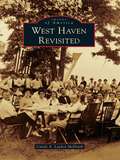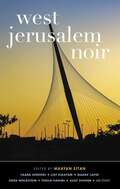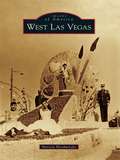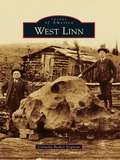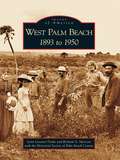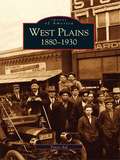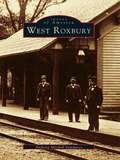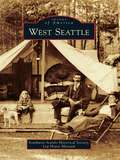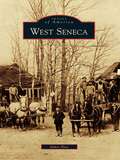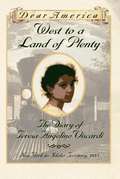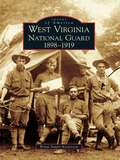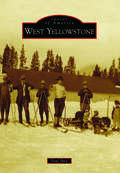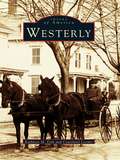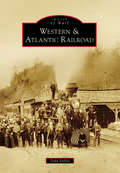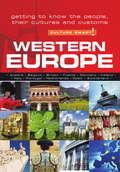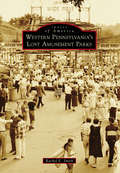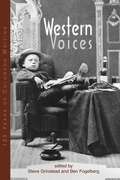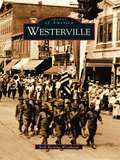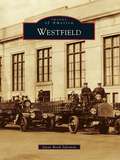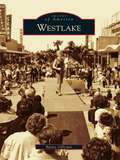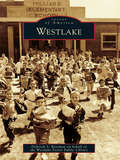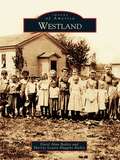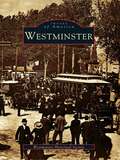- Table View
- List View
West Haven Revisited
by Carole A. McelrathFor more than 350 years, the hardy southern New England coastal town of West Haven has made its mark on the nation's history. From the days when Pres. George Washington's fledgling government gave permission to install a dike at Oyster River to Pres. Barack Obama's recognition of the West Haven Black Heritage Committee's leaders, the town has reflected, in miniature, the growth of America. Important people like movie theater mogul Sylvester Z. Poli, his granddaughter Jeanne Poli, and the entrepreneurs who created Savin Rock Amusement Park helped shape West Haven's development. The town's history was also impacted by Queen Victoria and Robert Todd Lincoln's correspondence concerning the rededication of the Campbell grave site, the "Razorbacks connection," and the 1882 murder of Jennie Kramer.
West Jerusalem Noir (Akashic Noir Series)
by Maayan EitanIn West Jerusalem Noir—published simultaneously with East Jerusalem Noir—the Akashic Noir Series visits one of the world's most complex locales, in this volume from the perspective of Israeli writersFrom the editor's introduction:"This anthology offers a fictional tour of Jerusalem, this time through the lens of the noir genre. Not all the stories in this book include a detective, a femme fatale, or a dead body. In fact, a significant number of the writers chose to avoid these genre staples. And yet the stories—each taking place in a different part of the city—sketch a dark imagined map of the city, where religious mystery dwells alongside the quotidian, claustrophobic hubbub of the Central Bus Station . . . The stories included in West Jerusalem Noir could not have taken place anywhere else. They reflect national, religious, and socioeconomic tensions inherent to the city and sketch an image of a concrete, contemporary, and complicated Jerusalem." Featuring brand-new stories by: Yiftach Ashkenazi, Ilana Bernstein, Emanuel Yitzhak Levi and Guli Dolev-Hashiloni, Liat Elkayam, Asaf Schurr, Yardenne Greenspan, Ilai Rowner, Zohar Elmakias, Ilan Rubin Fields, Nano Shabtai, Yaara Shehori, Tafat Hacohen-Bick, Nadav Lapid, Tehila Hakimi, and Oded Wolkstein. West Jerusalem Noir is being published simultaneously with East Jerusalem Noir, edited by Rawya Jarjoura Burbara. The companion volume explores the city with brand-new stories by Palestinian authors.
West Las Vegas
by Patricia HershwitzkyOriginal Las Vegas faced stiff odds with fluctuating fortunes throughout the 20th century. Celebrated as the McWilliams Townsite in 1904, Las Vegas's first commercial enterprise was quickly crushed by savvy developers owning most of the water rights on the southeast side of the railroad tracks. Deprived of resources and services, the tent-riddled ground soon earned the name Ragtown and was populated by the area's poorest, the majority being minorities. During the 1940s and 1950s, a soaring influx of blacks from small plantation towns in the South descended upon Las Vegas, seeking a promised land during the boom of wartime industry, but Jim Crow laws flew in with them. Ironically, segregation led to the emergence of the Westside as an enclave of successful businesses, services, entertainment and casino venues, dozens of churches, and middle-class housing. Although integration brought an exodus and decline, a bold new generation of West Las Vegans is once again revitalizing the original Westside community.
West Linn
by Cornelia Becker SeigneurThe largest iron meteorite discovered in the United States, weighing 15.5 tons, was unearthed in West Linn in 1902 and featured in the 1905 World's Fair before journeying to New York's American Museum of Natural History, where it remains. West Linn was carved onto the map years before, when Robert Moore purchased 1,000 acres of land in 1840 from the Wallamut Indians at Willamette Falls. Soon a lumber mill and flour mill were established, and the region was given a new name--Linn City--after free-state advocate Lewis F. Linn. Hugh Burns and the Miller, Fields, and Walling families also figured in early West Linn history. Though an 1861 fire, then flood, destroyed what was Linn City, the falls continued drawing industry. Officially incorporated into Oregon in 1913, West Linn, known for its hills, trees, rivers, and famous meteorite, is a sought-after community in which to raise families and made the 2005 top-100 list of best places to live.
West Palm Beach: 1893 to 1950
by Richard A. Marconi Historical Society of Palm Beach County Lynn Lasseter DrakeWest Palm Beach was established in 1894, two decades after pioneers first arrived in the wilderness at Lake Worth. In 1893, Henry M. Flagler, Standard Oil magnate and Florida railroad mogul, finalized plans to extend his Florida East Coast Railroad south in order to turn Palm Beach into a winter playground for the rich. He designed West Palm Beach as the mainland commercial and residential support for his new resort. From its humble beginnings, it has become Palm Beach County's largest city and the seat of government. The city has suffered fires, hurricanes, boom times, and hard times, always emerging triumphantly. This installment of West Palm Beach's fascinating story shares its unique settlement and growth through the end of World War II.
West Plains: 1880-1930 (Images of America)
by Toney AidOn the eve of the Civil War, West Plains was a sleepy county seat with a population of 150 and a wood-frame courthouse in its town square. During the war, this Southern Missouri town was burned, abandoned, and eventually reconstructed. With the arrival of the railroad in 1883, West Plains turned boomtown, and photographers were among the first entrepreneurs to arrive. This volume of vintage photographs documents the town as it grew, struggled, and prospered over the next 50 years. Pictured here are the washwomen and the bankers, the circuses and the fires, the schools and homes that helped build the West Plains of today.
West Roxbury (Images of America)
by Anthony Mitchell SammarcoWest Roxbury, located along the scenic Charles River, is a community of tree-lined streets and panoramic views, which has undergone tremendous changes since its incorporation as a town in 1851. Formerly known as "Westerly" or "South Street," West Roxbury has grown from a largely rural area, accessible only by train, into a charming neighborhood of Victorian homes that still offers many of the same advantages that attracted people a century ago--the quietness of small town life, with the attractions of big city living just a short distance away. West Roxbury is also the former home of Brook Farm, a utopian community founded by Reverend Ripley. Brook Farm was a center of literary achievement that attracted such foremost thinkers of the nineteenth century as Nathaniel Hawthorne, Ralph Waldo Emerson, and Horace Greeley.
West Seattle
by Southwest Seattle Historical Society Log House MuseumThe idea of a big city named New York Alki began in 1851 with the arrival of the Bell, Low, Denny, Boren, and Terry families on a Puget Sound shore. Since that rough beginning, logging, farming, shipbuilding, fishing, steel manufacturing, trolleys, and bridges have shaped the area's people and built communities. Beaches on Puget Sound and a river leading inside the country have defined the Duwamish Peninsula. In 1907, long having discarded the misfit name New York, the town of West Seattle was annexed into Seattle. Being the largest landmass annexed to Seattle brought advantages while West Seattle's neighborhood distinction and independent spirit remained.
West Seneca
by James PaceWest Seneca's history as a working community can be seen in its humble Native American cabins, sturdy Ebenezer Society buildings, simple farms, hardscrabble shops, and blue-collar housing tracts. In the 1700s, the Seneca Indians became the most dominant tribe when the town was part of the Buffalo Creek Reservation. In the 1840s, the arrival of the Ebenezer religious community from Germany continued the area's mostly agricultural development, and they formally incorporated the town in 1851. Their departure in the 1860s led to the arrival of more immigrants, primarily farmers, laborers, and shopkeepers. The next 100 years in West Seneca saw its development continue. In the 1950s, a further influx of new residents looking for affordable homes in a suburban setting led to the town's rapid growth as a mecca for working people.
West to a Land of Plenty: The Diary of Teresa Angelino Viscardi (Dear America)
by Jim MurphyThe first humorous book in the Dear America series, "West to a Land of Plenty" follows an Italian girl's immigrant family as they move from New York City to a utopian community in the frontier West.
West Virginia National Guard: 1898-1919 (Images of America)
by Brian Stuart KestersonThe formation of what would eventually become the West Virginia National Guard has its roots intertwined in the "Old" Virginia Militia system of the early and mid-1700s. This militia system spanned the Indian hostilities of the French and Indian War, American Revolutionary War, 1780s and 1790s Indian Wars, and Civil War. Images of America: West Virginia National Guard covers the time span between 1898 and 1919. This period of guard history was chaotic, to say the least, and was typified by turbulent social, economic, and political unrest.
West Whiteland Township
by Janice Wible EarleyLocated in Chester County, Pennsylvania, West Whiteland Township was established in 1765 when Whiteland Township divided into "East" and "West." Readers can glimpse into the past at establishments such as The Guernsey Cow restaurant, Strawbridge & Clothier, and the Valley Creek Coffee House. A chapter on Richard Downing provides firsthand accounts by quoting personal letters of his life in West Whiteland in the 1850s. There are beautiful photographs from the time when riders chased foxes as members of the Whiteland Hunt. The township began to change after the invention of the automobile; for over 100 years, the area had primarily been a farming community, until businesses began to spring up along Lincoln Highway and Pottstown Pike. With rapid development in the late 1970s and 1980s, many historic buildings were saved through the preservation efforts of the West Whiteland Historical Commission.
West Yellowstone
by Paul SheaFounded in 1908 to provide services for visitors arriving at the west entrance of Yellowstone National Park, the town of West Yellowstone, Montana, serves tens of thousands of international travelers each year. From 1908 to 1960, visitors arrived on Union Pacific Railroad parlor cars and boarded awaiting stagecoaches or, in later years, touring buses to embark on their journey to Wonderland. The railroad no longer serves this popular gateway city, but West Yellowstone boasts the largest and most historically intact railroad complex built specifically to serve national park tourists. This historic railroad district, as well as the town, imparts to many visitors a sense of the adventure experienced during the golden age of railroad travel and public transportation.
Westerly (Images of America)
by Kathleen M. Fink Courtland LoomisThese images take us on a journey into the past. We see pictures of local buildings and businesses, many of which no longer exist but are still warmly remembered by native citizens, and we also see the many stages of development, including street widening and drainage, which have revolutionized life for local people over the decades. Other photographs show how much transport in particular has changed, as we see the great sailing vessels of the early nineteenth century and early modes of transport such as horses and carriages and open trolleys. From livery stables in the 1800s we are transported to the era of the automobile with pictures of Hoxsie Plymouth Dodge in the early 1900s and early autos from the 1920s and 1930s. There are images of the famous local Smith quarries, showinggranite employees at work and the oxen-drawn carts used at that time. Taken over many decades, the photographs collected here bring home just how much the town has changed over the years. We experience bad times as well as good as we witness the many fires which have so drastically changed the landscape of Westerly and also the harsh years of the 1930s when the area was devastated by the Great Depression. Most important of all, we encounter the local people of Westerly, at work and at play over the decades, including school groups, sports teams, fraternities, and individual portraits of the men, women, and children who have created Westerly's history. Combining fascinating old photographs and concise, yet informative, text, this compelling visual history will delight young and old, resident and visitor alike.
Western & Atlantic Railroad (Images of Rail)
by Todd DeFeoThe State of Georgia chartered the Western & Atlantic Railroad in 1836. The railroad aided in the development and growth of many communities between Atlanta and Chattanooga, Tennessee. In constructing the railroad, workers created a winding route that cut its way across the North Georgia landscape. During the Civil War, both armies used this vital artery, and it was the setting for one of the war's most iconic events, the Great Locomotive Chase. The state still owns the Western & Atlantic and has leased it since 1870. The line remains an essential part of North Georgia and is a backbone of the region's industry. As Atlanta ponders its transportation future, it is important to remember that without the Western & Atlantic, Atlanta would not be the city it is today.
Western Europe - Culture Smart!
by Roger JonesThe historic countries of Western Europe - Austria, Belgium, Britain, France, Germany, Ireland, Italy, Portugal, Netherlands, Spain, and Switzerland - are the jewels in the crown of European civilization. Their importance and attraction for the rest of the world are so great that the region is the prime travel destination for businesspeople, tourists, and students. Western Europe is a relatively compact geographical area, containing an enormous diversity of landscapes, peoples, and cultures. The historically competitive Western Europeans are unlike each other in many ways, yet share an underlying system of values, and the restless Western European spirit of enquiry, enterprise, and adventure has had a decisive impact on world history. In the past, their empires spread their languages, religions, arts, and ideologies around the globe, and today the world beats a pathway to their doors. For foreign visitors, first encounters in Western Europe can be overwhelming. The richness and complexity of the different national cultures are difficult to take in, and people's behavior and reactions can be surprisingly unpredictable.For example, attitudes to time vary. In Germany it's rude to be late; in France it's rude to be on time. In business there is a range of negotiating styles. And because there is more to communication than speech, it is easy to misread the signals in other people's societies. Even smiling can sometimes be wrong - in France it's distinctly uncool to smile at strangers. Western Europe is ideal for student travelers, businesspeople, or academics who will be visiting several countries on their trip and who don't wish to be burdened with eleven books on different destinations. In this it is unique. No other book captures the essence of eleven national cultures in a single volume. Drawing on the wealth of information in the individual Culture Smart! country guides, it focuses on those situations in each country where visitors are likely to come into contact with local people. Beyond listing the dos and don'ts, it explains the cultural context of different or unexpected behavior. It tells you about beliefs and attitudes, and alerts you to local manners and sensitive issues. Full of fascinating insights and practical advice, it will help you navigate your way through uncharted seas, avoid gaffes and misunderstandings, and establish a rapport with people wherever you are.
Western New York Amusement Parks (Images of America)
by Rose Ann HirschFor more than 100 years, western New Yorkers have enjoyed the region's exciting amusement parks. During the days of trolleys and steamships, area businessmen created Celoron Park, Crystal Beach Park, and other fine local summer resorts. Decades later, lifelong memories were formed for neighborhood baby boomers who visited Glen Park and Fantasy Island, as well as one of New York State's finest theme parks, Darien Lake. Western New York has always been a proving ground for some of the nation's most famous roller coasters. The terrifying Cyclone, the fast and furious Silver Comet, and the extreme Ride of Steel have attracted the very bravest of visitors. In the new millennium, the summer tradition of visiting local amusement parks continues with a blend of family-orientated parks and theme parks that appeal to all ages.
Western Pennsylvania's Lost Amusement Parks (Images of America)
by Rachel E. SmithAt one time, Western Pennsylvania was home to dozens of small amusement parks, many of them trolley parks. These parks, originally designed to bolster streetcar business, were a way for workers to seek respite from the crowded, dirty cities. While some of these parks never developed into much more than a dance hall and a merry-go-round, others became full-scale amusement parks with rides, entertainment, and other amusements. After years of battling floods, changing economies, the decline of streetcars, and competition from other amusement parks, many of these amusement parks ended up closing their gates for good, the thrills they once provided now relegated to memories. With many of these parks all but lost to time, it is time to take a look back and remember some of the most prominent lost amusement parks of Western Pennsylvania.
Western Voices: 125 Years of Colorado Writing
by Steve Grinstead Ben Fogelberg Tom NoelEver since the region's first inhabitants chiseled petroglyphs and scratched pictographs on canyon walls, westerners have celebrated and recovered their history. Foremost among Colorado institutions to collect, preserve, exhibit, and publish has been the 125-year-old Colorado Historical Society. The Colorado Historical Society is home to a mother lode of the West's literary legends. This commemorative collection of the best of the best in Colorado writing includes noted essayists and writers such as Louis L'Amour, Wallace Stegner, Patricia Nelson Limerick, Thomas J. Noel, and many, many more.
Westerville (Images of America)
by Beth Berning WeinhardtWesterville, Ohio, once known as the "Dry Capital of the World," has carved a niche for itself in history that few small towns can boast. Its industrious citizens founded Otterbein College, shaped an active business and social community, and attracted the nation's attention by taking a strong stand on the sale of alcohol. Wooed by the promise of land in a "dry" community, the Anti-Saloon League located their printing headquarters in the village in 1909. The photographs in this book capture Westerville as it grew and changed from the 19th century to 1961, when it officially became a city.
Westfield (Images of America)
by Jayne Book SalomonWestfield is a thriving suburban community, rich in history, culture, and civic pride. Located just 22 miles outside of New York City, it is affectionately know as "Colonial Westfield." In 1720, the "West Fields" of Elizabeth Town were settled by English immigrants. During the Revolutionary War, several altercations with the Red Coats took place here. Not only did George Washington stop in Westfield during the Revolutionary War, but it is believed he slept at the home of one of the town's forefathers. After the advent of the railroad in mid-1800s, the small but productive farming village gradually developed into the attractive upscale community it is today. Known for its high standards in education, emphasis on the arts, and religious and civic institutions, Westfield is one of the few suburban towns in New Jersey that continues to maintain an active downtown shopping area, complete with a major department store. With approximately 50 restaurants, it draws visitors from all over the state.
Westlake
by Bunny GillespieThe Westlake section of Daly City is the quintessential postwar suburban-modernist development, and it was the singular vision of Henry Doelger that made it so. Westlake was to the San Francisco Bay Area what Levittown was to New York after World War II, providing affordable housing for thousands of service veterans and war-industry personnel who remained in California after their tours of duty. The area abuts San Francisco's Sunset District, where Doelger built thousands of homes in the shifting sands before battling the dunes in northern San Mateo County in 1948. Doelger was lauded as the Bay Area's bestknown builder of homes, apartments, and shopping centers. Daly City increased in size almost by half when Westlake was annexed in 1948.
Westlake (Images of America)
by Westlake Porter Public Library Deborah S. RossmanThe city of Westlake was originally settled as part of Dover Township. In the period between 1811 and 1840, the pioneers cleared the forest to make way for agriculture. The land shaped the boundaries of the township, a 15.9-square-mile area rich in farms, dairies, orchards, and vineyards. The town's businesses grew and prospered, and Dover became the second-largest shipping point for grapes in the United States. Over time the farms have disappeared from the landscape, but the city's proud heritage continues today. Westlake is an opportunity to experience not only the past events in the city of Westlake but also the lives of the people who call Westlake home.
Westland (Images of America)
by Daryl Alan Bailey Sherrye Louise BaileyIn May of 1825, Reverend Marcus Swift traveled along the middle branch of the Rouge River until he found a place he thought was close to heaven. Soon streets, homes, and businesses were established as more pioneers arrived in Nankin Township. In 1963, the J.L. Hudson Company chose Nankin Township as the site of a new shopping mall called Westland. When the mall became a target for annexation, residents joined forces to create their own city. Thus, the city of Westland was born. Through rare photographs drawn from various sources, this book takes readers on a journey through nearly 200 years of local history, from the death of Chief Tonquish to the present day.
Westminster
by Westminster Historical SocietyIt almost was not Westminster. The small town in central Massachusetts was born to another name, that of Narragansett 2, and it was not for another twenty years that the area became known as Westminster. One early settler, Abner Holden, described it as "a howling wilderness." Today's Westminster is a charming Colonial town, with the impressive peak of Mount Wachusett overlooking its rolling hills and its pristine lakes and ponds.In Westminster, the story unfolds from the first settlers gathering on Academy Hill to weather the bleak early years to the joyous return of the soldiers from the bloody battles of World War II. It portrays the early inventive entrepreneurs, along with the sturdy men and women who made the town's blueberries famous and its chickens delicious. Savor the memories of the Westminster Cracker Factory and the golden corn fritters of the well-known Old Mill Restaurant, recall the bustling chair factory of Artemus Merriam, and remember the wartime heroes and eager faces of Westminster's children. Capture in Westminster the spirit of the town's residents joining together in celebration and tragedy, from the first festive centennial parade to the pain of devastating fires.
